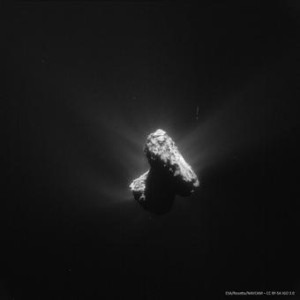Europe’s Philae lander has relayed science data to the Rosetta orbiter circling Comet 67P/Churyumov-Gerasimenko.
Measurements taken by the Philae’s COmet Nucleus Sounding Experiment by Radiowave Transmission (CONSERT) instrument were at first shaky, but then remained solid for some 12 minutes.
“This sign of life from Philae proves to us that at least one the lander’s communication units remains operational and receives our commands,” said German Aerospace Center (DLR) engineer Koen Geurts, a member of the lander control team at DLR Cologne.

The Lander Control Center (LCC) at the German Aerospace Center (Deutsches Zentrum für Luft- und Raumfahrt; DLR) facility in Cologne is responsible for the commanding and operation of the Philae lander.
Credit: DLR (CC-BY 3.0)
Mood swings
According to the DLR, the mood had been mixed over the last few days; Philae had not communicated with the team in the DLR Lander Control Center (LCC) since June 24, 2015.
After an initial test command to turn on the power to CONSERT on July 5, 2015, the lander did not respond. Philae’s team began to wonder if the lander had survived on the comet.
There was great excitement when Philae “reported in” on June 13, 2015 after seven months of hibernation, transmitting data about its health.
However, Philae has to communicate with the ground stations through the Rosetta orbiter, which serves as a radio relay to Earth.
Philae’s internal temperature of zero degrees Celsius gives the team hope that the lander can charge its batteries. If so, this would make scientific work possible regardless of the “time of day” on the comet.
Puzzlement
Currently, DLR’s lander team is evaluating the data that were received.
“We can already see that the CONSERT instrument was successfully activated by the command we sent on July 9,” explained Geurts.
Even now, Philae is causing the team some puzzlement.
There is no explanation for why the lander has communicated now, but not over the past few days.
The trajectory of the orbiter, for example, has not changed over the last three weeks.
However, one thing is certain.
Philae has survived the harsh conditions on the comet and is responding to commands from the DLR Lander Control Center team.
“This is extremely good news for us,” Geurts said.




